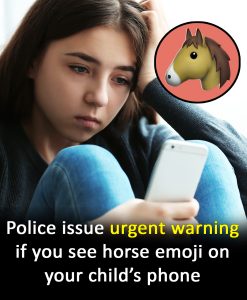Being a parent in today’s digital world brings a whole new set of challenges that previous generations never had to face. With smartphones, social media, and instant messaging, kids are more connected than ever before—but that doesn’t always mean they’re safe. The internet offers an endless stream of communication, entertainment, and information, but it also opens the door to dangers that parents may not even realize exist. One of the latest concerns? A simple emoji that might seem innocent at first glance, but could be a warning sign of something much more troubling.

As social media continues to evolve, so does the way young people communicate. Emojis, those small digital icons meant to represent emotions, objects, or ideas, have become part of a secret language that teens and even younger kids use to talk with one another—often without adults understanding what they’re really saying. While it’s easy to assume that a smiley face or animal icon is exactly what it appears to be, the reality is far more complex.
Police departments across the United States are now warning parents about certain emojis that are being used as coded references for drugs and even dangerous ideologies. One emoji in particular—the horse emoji 🐴—has caught their attention for its disturbing hidden meaning. Though many parents might assume their child is referencing ponies or horseback riding, this emoji is now being used among teens to represent ketamine, a powerful anesthetic drug known for its hallucinogenic effects. Also known as “Special K,” ketamine is increasingly being abused by young people, and the use of this emoji is just one way they are trying to keep their activities hidden from parents and authorities.
The concern goes far beyond just the horse emoji. Law enforcement has shared a growing list of emojis that are being used to discreetly reference various illegal substances. For example, an alien, skull, or demon face might be code for MDMA, also known as ecstasy or “Molly.” A snowflake or snowman can signify cocaine. Maple leaves, trees, or four-leaf clovers may represent marijuana. Even innocent-looking emojis like cake, ice cream, grapes, lemons, or cherries can be used to indicate edible cannabis products. What’s alarming is that these icons are being used so casually and frequently that it can be difficult for parents to detect the danger unless they know what to look for.
But the risks aren’t limited to drug references. The popular Netflix series Adolescence has recently shined a light on how certain online communities are using emojis as part of a broader effort to radicalize young people—especially boys. The show follows a 13-year-old boy who becomes immersed in online content from the so-called manosphere, a collection of toxic online spaces that promote misogyny and anti-feminist beliefs. The story takes a dark turn, ending in a tragic act of violence, highlighting just how serious these influences can become.
In the show, and in real life, emojis are being used to express dangerous ideologies. For example, the dynamite emoji has become a symbol within incel communities, representing the idea of an “exploding red pill”—a reference to the belief that they’ve awakened to the so-called truth about society and women. The 100 emoji is tied to the “80/20 rule,” which claims that 80% of women are only attracted to 20% of men. The kidney bean emoji is sometimes used to label someone as an incel. These codes allow users to communicate in ways that fly under the radar of parents, teachers, and even tech companies.
Dr. Robert Lawson, a sociolinguist from Birmingham City University in the UK, recently explained how the red pill emoji (💊) is used in these communities to symbolize a supposed awakening to harsh “truths” about the world. Originally a concept from The Matrix, where taking the red pill meant seeing the world for what it really was, this idea has been co-opted by extremists who twist it into a justification for their harmful beliefs.
So, what can parents do to protect their children in this fast-changing digital landscape? First and foremost, it’s important to stay informed. Take time to learn what today’s slang and emojis really mean, especially those that are commonly used in online spaces. Open and honest communication is also essential. Talk to your kids regularly about the realities of the online world—everything from drug use to harmful ideologies—and let them know they can come to you with questions or concerns.
It’s also smart to keep an eye on your child’s digital activity without being overly invasive. Monitoring doesn’t mean reading every single message, but knowing what platforms they use, who they interact with, and being aware of any red flags can go a long way. Parental controls can also help filter out harmful content and alert you to potentially risky behavior.
At the end of the day, the internet can be a powerful tool for learning and connection, but it also comes with risks that can’t be ignored. By staying educated, having regular conversations, and using the available technology to guide and protect your children, you can help create a safer online experience for them.
The key is not to panic, but to prepare. Emojis may seem small and harmless, but they can carry big meanings—some of which may be harmful or even dangerous. Parents who take the time to understand these symbols are better equipped to spot potential warning signs and take action before it’s too late.
If you found this information helpful, share it with other parents. The more we all know, the better we can protect our children in a digital world that’s constantly evolving.